RBSE Solutions for Class 11 Maths Chapter 10 Straight Lines Ex 10.1
Rajasthan Board RBSE Solutions for Class 11 Maths Chapter 10 Straight Lines Ex 10.1 Textbook Exercise Questions and Answers.
Rajasthan Board RBSE Solutions for Class 11 Maths in Hindi Medium & English Medium are part of RBSE Solutions for Class 11. Students can also read RBSE Class 11 Maths Important Questions for exam preparation. Students can also go through RBSE Class 11 Maths Notes to understand and remember the concepts easily.
RBSE Class 11 Maths Solutions Chapter 10 Straight Lines Ex 10.1
Question 1.
Draw a quadrilateral in cartesian plane, whose vertices are (- 4, 5), (0, 7), (5, - 5) and (- 4, - 2).
Also find its Area.
Answer:
In the figure by given vertices A(- 4, 5), B(0, 7), C(5, - 5) and D(- 4, - 2) graph of quadrilateral ABCD is shown in cartesian plane.
Here, A(- 4, 5) = x1 = - 4, y = 5
8(0, 7) ⇒ x2 = 0, y2 = 7
C(5, - 5) ⇒ x3 = 5, y3 = 5
D(- 4, - 2) ⇒ x4 = - 4, y4 = - 2
Draw diagonal AC. Now, area of quadrilateral ABED will be equal to the sum of areas of ∆ABC and ∆ACD.
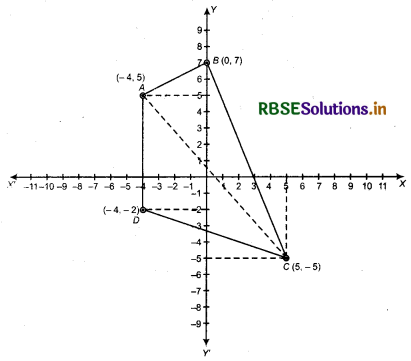
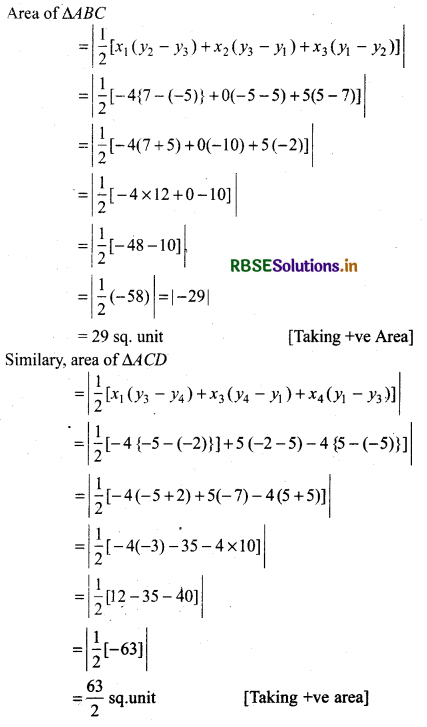
Thus, area of quadrilateral ABCD
= Area of ∆ABC + Area of ∆ACD
= 29 + \(\frac{63}{2}=\frac{58+63}{2}=\frac{121}{2}\) sq.unit
Thus, area of quadrilateral = \(\frac{121}{2}\) sq. unit

Question 2.
The base of an equilateral triangle with side la lies along the y-axis such that the mid-point of the base is at the origin. Find the vertices of the triangle.
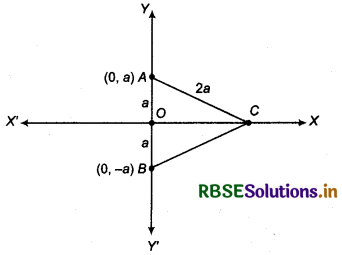
Answer:
∆ ABC is an equilateral triangle whose side is 2a. Base of ∆ ∆BC is along the y-axis and the mid-point is origin.
Distance of vertex A from origin O = a
Distance of vertex B from origin O = a
So, coordinates of A and B will be (0, a)and (0, - a) respectively.
[Since, their abscissa will be zero]
Let coordinates of vertex C be (x, 0).
Now, AC = \(\sqrt{(x-0)^2+(0-a)^2}\) = 2a (∵ AC = 2a)
⇒ \(\sqrt{x^2-a^2}\) = 2a
⇒ x2 + a2 = 4a2
⇒ x2 = 4a2 - a2
⇒ x2 = 3a2 or x = ±a√3
Thus, coordinates of C are (± √3a, 0)
Thus, vertices of triangle are A(0, a), B(0, - a)and C
(√3a, 0) or A(0, a), B(0, - a) and C(-√3a, 0).
Question 3.
Find the distance between P(x1, y1) and Q(x2, y2) when
(i) PQ is parallel to the y-axis
(ii) PQ is parallel to the x-axis
Answer:
P(x1, y1) and Q(x2, y2)
Distance between the points P and Q is
PQ = \(\sqrt{\left(y_2-y_1\right)^2+\left(x_2-x_1\right)^2}\)
(i) When line PQ is parallel to y-axis, then abscissa of its each point will be same, since it will be at definite distance from y-axis.
So, x1 = x2 = a(say)
⇒ x1 - x2 = 0
From equation (1), we have
PQ = \(\sqrt{\left(y_2-y_1\right)^2}\)
or PQ = |y2 - y1|
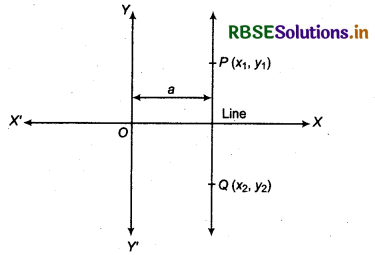

(ii) When line PQ is parallel to x-axis, then ordinate (y-coordinate) of each point will be same, since line will be at definite distance from x-axis.
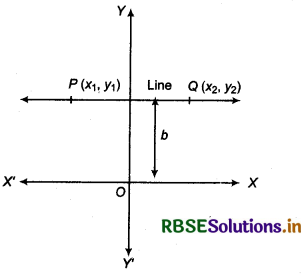
So, y1 = y2 = b (say)
⇒ y1 - y2 = 0
From equation (1), we have
PQ = \(\sqrt{\left(x_2-x_1\right)^2}\)
Thus, PQ = |x2 - x1|
Question 4.
Find a point on x-axis. which is equidistant from the points (7, 6) and (3, 4).
Answer:
Let C(x, 0) by any point on x-axis which is equidistant from the points A(7, 6) and B(3, 4).
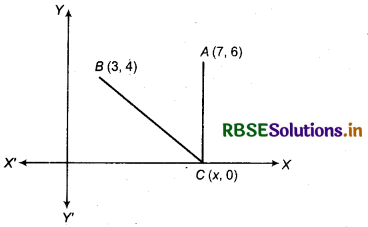
Distance between the points C(x, 0) and A(7, 6)
= Distance between the points C(x, 0) and B(3, 4)
⇒ CA = CB
\(\sqrt{(7-x)^2+(6-0)^2} = \sqrt{(4-0)^2+(3-x)^2} \)Squaring both sides, we have
⇒ (7 - x)2 + 62 = (3 - x)2 + 42
⇒ 49 + x2 - 14x + 36 = 9 + x2 - 6x + 16
⇒ 49 + 36 - 16 - 9 = 14x - 6x
⇒ 60 = 8x
⇒ x = \(\frac{60}{8}\) = \(\frac{15}{2}\)
Thus, coordinates of required points are \(\left(\frac{15}{2}, 0\right)\).

Question 5.
Find the slope of a line. which passes through the origin, and the mid-point of the line segment joining the points P(0, - 4) and 8(8 0).
Answer:
Coordinates of mid-point of points P(0, - 4) and B(8, 0)
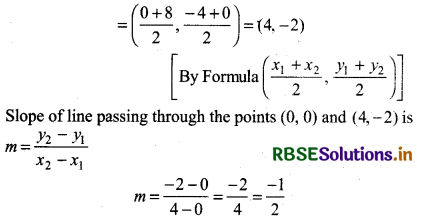
Thus, slope of required line m = - \(\frac{1}{2}\)
Question 6.
Without using the Pythagoras theorem, show that the points (4, 4), (3, 5) and (- 1, - 1) are the vertices of a right-angled triangle.
Answer:
Let A = (4, 4), B = (3, 5) and C = (- 1, - 1)
Now slope of AB = \(\frac{5-4}{3-4}=\frac{1}{-1}\)
Slope of BC = \(\frac{-1-5}{-1-3}=\frac{-6}{-4}\)
and slope of CA = \(\frac{-1-4}{-1-4}=\frac{-5}{-5}\) = 1 = m3
We see that
Slope of AB × Slope of CA = (- 1) × (1) = - 1
⇒ m1 × m3 = - 1
So, AB and CA are perpendicular to each other
In ∆ABC, ∠A = 90°
Thus, the given points are vertices of a right angle triangle.

Question 7.
Find the slope of the line, which makes an angle of 30° with the positive direction of y-axis measured anticlockwise.
Answer:
As in figure, line l makes an angle of 30° anticlockwise in positive direction of y-axis and cuts y-axis at Q and x-axis at P.
Coordinates of Q(0, y) and coordinates of P(x, 0).
[Q is at y-axis so abscissa = 0
P is at x-axis so ordinate = 0]
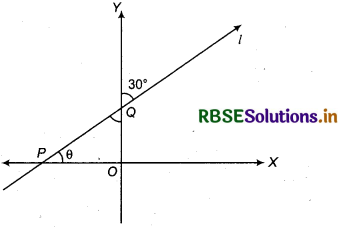
Slope of line, m = tan θ
In ∆OQP. ∠PQO = 30°
and θ = 90° - 30° = 60°
Thus, m = tan 60° = √3
Question 8.
Find the value of x, for which the points (x, - 1), (2, 1) and (4, 5) are collinear.
Answer:
Let A = (x, - 1), B = (2, 1) and C = (4, 5)
All three points are collinear if
Slope of AB = Slope of BC
i.e. m1 = m2
then \(\frac{1-(-1)}{2-x}=\frac{5-1}{4-2}\)
⇒ \(\frac{1+1}{2-x}=\frac{4}{2}\) = 2 ⇒ \(\frac{2}{2-x}\) = 2
⇒ 2 = 2(2 - x)
⇒ 2 = 4x - 2x
⇒ 2x = 2
Thus, x = 1

Question 9.
Without using distance formula, show that the points (- 2, - 1), (4, 0), (3, 3) and (- 3, 2) are the vertices of a parallelogram.
Answer:
Let A = (- 2, - 1), B = (4, 0) C = (3, 3), D = (- 3, 2)
A(- 2, - 1) ⇒ x1 = - 2, y1 = 1
8(4, 0) ⇒ x2 = 4, y2 = 0
C(3, 3) ⇒ x3 = 3, y3 = 3
D(- 3, 2) ⇒ x4 = - 3, y4 = 2
Slope of AB
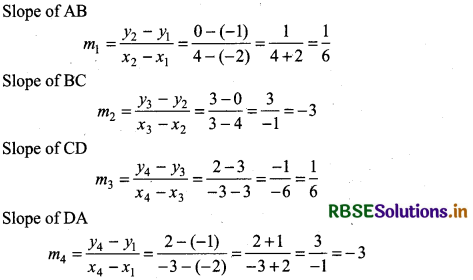
Clearly, slope of AB = Slope of CD = \(\frac{1}{6}\)
and slope of BC = Slope of DA = - 3
∵ AB || CD
and BC || DA
Thus, given points are vertices of a parallelogram.
Question 10.
Find the angle between the x-axis and the line joining the points (3, - 1) and (4, - 2).
Answer:
Let, (x1, y1) = (3, - 1)
and (x2, y2) = (4, - 2)
Slope of the line joining the points P(3, - 1)and Q(4, - 2)
m = \(\frac{y_2-y_1}{x_2-x_1}\)
= \(\frac{-2-(-1)}{4-3}\)
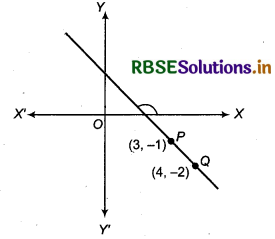
= \(\frac{-2+1}{1}\)
∴ m = - 1 (∵ m = tan θ)
∴ tan θ = - 1 ⇒ tan θ = tan 135° ⇒ θ = 135°
Thus, angle between given line and x-axis is 135°

Question 11.
The slope of a line is double of the slope of another line. If tangent of the angle between them is \(\frac{1}{3}\), find the slopes of the lines.
Answer:
Let slope of first line is m1 and of other line is m2.
Then according to the question m1 = 2 × m2
If θ be the angle between the lines, then
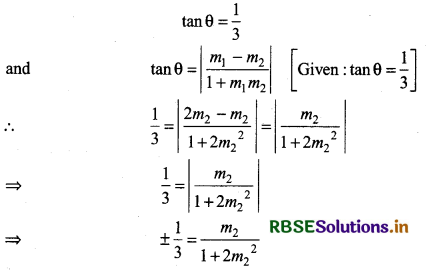
Taking +ve sign 3 × m2 = 1 + 2m22
⇒ 2m22 - 3m2 + 1 = 0
⇒ 2m22 - (2 + 1)m2 + 1 = 0
⇒ 2m22 - 2m2 - m2 + 1 = 0
⇒ 2m2 (m2 - 1) - 1(m2 - 1) = 0
⇒ (2m2 - 1) (m2 - 1) = 0
⇒ 2m2 - 1 = 0
⇒ m2 - 1 = 0
⇒ m2
⇒ m2 = 1
When m2 = \(\frac{1}{2}\), then m1 = 2 × \(\frac{1}{2}\) = 1
when m2 = 1, then m1 = 2 × 1 = 2
Taking - ve sign \(\frac{1}{3}=-\frac{2 m_2-m_2}{1+2 m_2^2}\)
⇒ \(\frac{1}{3}=-\frac{m_2}{1+2 m_2^2}\)
⇒ 1 + 2m22 = - 3m2
⇒ 2m22 + 3m2 + 1 = 0
⇒ 2m22 + 2m2 + m2 + 1 = 0
⇒ 2m2(m2 + 1) + 1(m2 + 1) = 0
⇒ (2m2 + 1) (m2 + 1) = 0
⇒ m2 = - \(\frac{1}{2}\) and m2 = - 1
When m2 = - \(\frac{1}{2}\), then m1 = 2 × \(\left(-\frac{1}{2}\right)\) = - 1
When m2 = - 1, then m1 = 2 × (- 1) = - 2
Thus, slope of lines are \(\frac{1}{2}\) and 1 or 1 and 2 or - \(\frac{1}{2}\) and - 1 or - 1 and - 2.
Question 12.
A line passes through (x1, y1) and (h, k). If slope of the line is m. Show that k - y1 = m(h - x1)
Answer:
Slope of line joining the points (x1, y1) and (h, k).
⇒ \(\frac{k-y_1}{h-x_1}\) = m (Given)
⇒ k - y1 = m(h - x1)
Thus, the equation of the line is: k - y1 = m(h - x1)
Hence Proved

Question 13.
If three points (h, 0), (a, b) and (0, k) lie on a line, then show that : \(\frac{a}{h}+\frac{b}{k}\) = 1.
Answer:
Let A = (h, 0), B = (a, b) and C = (0, k)
If points A, B, and C lie on a line i.e. collinear, then
Slope of AB = slope of BC
⇒ m1 = m2
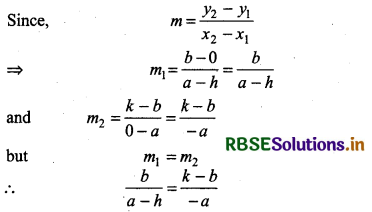
⇒ - ab = (k - b) (a - h)
⇒ - ab = ak - hk - ab + bh
⇒ ak + bh = hk .
Dividing both sides by hk, we have
\(\frac{a k}{h k}+\frac{b h}{h k}=\frac{h k}{h k}\)
Thus, \(\frac{a}{h}+\frac{b}{k}\) = 1
Hence Proved.
Question 14.
Consider the following population and year graph. Find the slope of the line AB and using it, find what will be the population in the year 2010?
Answer:
Given, point
A = (1985, 92)
B = (1995, 97)
Thus, x1 = 1985, y1 = 92
x2 = 1995, y2 = 97
Now, slope of the gradient of the line AB
m1 = \(\frac{y_2-y_1}{x_2-x_1}\)
m1 = \(\frac{97-92}{1995-1985}=\frac{5}{10}=\frac{1}{2}\)
Let in 2010, population will be y crore.
Then this point (2010, y) can be represented on line by i.e.
C = (2010, y)
Here, x3 = 2010, y3 = y
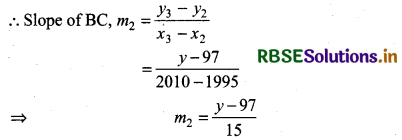
But points, A, B and C lie on same line.
∴ Slope of AB = Slope of BC
m1 = m2
∴ \(\frac{1}{2}=\frac{y-97}{15}\)
⇒ 15 × 1 = 2 × (y - 97)
⇒ 15 = 2y - 194
⇒ 2y = 194 + 15
⇒ 2y = 209
⇒ y = \(\frac{209}{2}\)
⇒ y = 1045
Thus, slope of AB is \(\frac{1}{2}\) and the population in the year 2010 is = 104.5 crore.

- RBSE Solutions for Class 11 Maths Chapter 3 त्रिकोणमितीय फलन Ex 3.1
- RBSE Solutions for Class 11 Maths Chapter 2 संबंध एवं फलन विविध प्रश्नावली
- RBSE Solutions for Class 11 Maths Chapter 2 संबंध एवं फलन Ex 2.3
- RBSE Solutions for Class 11 Maths Chapter 2 संबंध एवं फलन Ex 2.2
- RBSE Solutions for Class 11 Maths Chapter 2 संबंध एवं फलन Ex 2.1
- RBSE Solutions for Class 11 Maths Chapter 1 समुच्चय विविध प्रश्नावली
- RBSE Solutions for Class 11 Maths Chapter 1 समुच्चय Ex 1.6
- RBSE Solutions for Class 11 Maths Chapter 1 समुच्चय Ex 1.5
- RBSE Solutions for Class 11 Maths Chapter 1 समुच्चय Ex 1.4
- RBSE Solutions for Class 11 Maths Chapter 1 समुच्चय Ex 1.3
- RBSE Solutions for Class 11 Maths Chapter 1 समुच्चय Ex 1.2